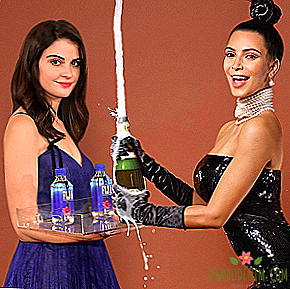The naked truth: Why sex no longer sells
February 8, New York Fashion Week.The most anticipated season show is the debut collection of Raf Simons as the new creative director Calvin Klein. Models come to the catwalk, both men and women, in almost identical outfits: tight, straight cut trousers, shirts fastened under the throat, perfectly tailored coats. At some point, a boy and a girl appear, dressed in identical sweaters with transparent chiffon inserts, through which bare breasts shine through. This fact is not astonishing at all (fortunately, many in our time, it is no longer surprising to have a bare nipple), but the fact that in both cases there is not a hint of the exploitation of sexuality. The aim of the designer was not a provocation, but a clear demonstration: sex today is by no means the main marketing tool in fashion.

It is noteworthy that at one time Calvin Klein actively translated the idea of "sex sells". Entrepreneurial Klein saw in time that scandalous PR was effective PR, and began shooting advertising campaigns with a minor, Brooke Shields, half-dressed and sometimes completely naked, Kate Moss and Mark Wahlberg and other frankly provocative visuals. Klein was repeatedly accused of promoting child pornography, especially after the 1995 advertising campaign, filmed by Stephen Meisel. Then the designers were called to account by the leaders of the Catholic community and the American Family Association.
The vector given by Klein was quickly picked up by the freshly appointed creative director of Gucci Tom Ford. But if in the case of the first sexual images were submitted as a metaphor of puberty, then Ford gave a start to a much more assertive marketing strategy. To bring the Italian brand out of stagnation, he took the technique honed by Klein and brought him to the absolute. In the advertising campaigns of the fashion house, one could see a model of Carmen Cass with the pubic-shaved letter G, in front of which a guy is on his knees, or two models who pose as if they are about to make love to the camera. Gucci became synonymous with aggressive sexuality, and this image leap not only brought the company a huge profit (by 2004, when Ford left the brand, Gucci was valued at $ 10 billion), but also served as an example to others.
Flirting with the theme of sex is, of course, not new: remember at least the latex pants and the T-shirts cut on the chest, which in the 1970s were made by Vivienne Westwood, or Thierry Mugler, all of whose work was built on the idea of a fetish. But it was in the 1990s that sex in advertising and pop culture ceased to be considered a way of marginal provocation and began working for the masses.


The scheme is simple: a brand launches a super provocative campaign that everyone is starting to talk about - in a positive or negative context, it doesn't matter. Publication of the brand is increasing, and even those who are not particularly interested in the vicissitudes of the fashion industry, in the field of view looms the right picture. In the end, the buyer gives up: he wants to join the image that the brand promotes, and goes to the store to buy, if not a bag, then at least perfume or lipstick. The more reasons for discussing your name you gave, the higher your rating was - as the usual expression says, "there is no bad PR."
This technique worked for zero. We inherited an unequivocal footage of the 2004 Calvin Klein campaign with Natalia Vodianova, as well as the scandalous story of Madonna in the 2009 shooting for Louis Vuitton, or the D & G Spring-Summer 2007 advertising campaign, which was not without reason called "group rape." However, over time, it became clear that the marketing campaigns that had been worked out over the years no longer work.
For the first time, they talked about desexualization of fashion advertising a couple of years ago, although the corresponding moods appeared much earlier. The year before, Alexander Wang released the first advertising campaign for his denim line, using the nude model Anna Evers as the main character. It would seem that the young designer followed all of Klein's precepts: jeans, between which and the body of the “nothing is not” model, provocative poses, a characteristic facial expression. Only now, “thirty years later,” such a straightforward approach does not look very relevant.

If at the beginning of the 90s a public demonstration of naked bodies caused fair indignation among adults, and a logical interest among teenagers, in the 2010s, when sex became an ordinary part of popular culture, a photo of a hand thrown into pants looks like an unsophisticated way to make money. This was understood even by the creators of the odious Pirelli calendar, which for several decades prioritized conventional erotica. The release of 2016 was strikingly different from everything that the company had done before: no sexual objectification of women — most of the heroines were completely depicted completely dressed. The fact that Pirelli, who made millions on the exploitation of the "sex for sale" principle, decided on such an abrupt change in concept, suggests that tectonic shifts are occurring.
The advertising rate has changed - largely because buyers have changed. In a WWD portal article on the desexualization of fashion advertising, psychologist Keith Yarrow says: “Millennials are much more casual about sex - they don’t want to look deliberately sexy, they like calm, relaxed images.” They stopped paying attention to sex - now it’s rather a pleasant addition to other everyday worries. Perhaps its value also negates the fact that the new generation has easy access to everything that the public morality once banned: day by day we see sex in music videos, films and on the Internet.
Last summer, The Independent released an article that said that generation Y is the first in history to have sex several times less than their parents, being at the same age. The reason for this is an unstable world situation: we are constantly under stress, we have to work more hours, so as not to lose a stable source of income. The availability of online porn and sex toys has changed the status quo: in order to satisfy sexual desire, it is no longer necessary to seek contact with a person - this can be done alone.


As soon as sex began to be perceived as something ordinary, it ceased to be interesting, and therefore it became ineffective to use images with an erotic slant. They were replaced by more pressing topics, such as acute social problems. So, feminism has already been taken on a pencil by Dior, Nike (the latest commercial released by the company is the best proof of this) and Prabal Gurung. The idea that a woman is more important to like herself, build a career and be strong and independent, and not serve as an object of desire, builds the visibility of such brands as, for example, Céline, The Row and Lemaire. In other words, sexuality has ceased to be a sales engine, and brands have to look for new ways to communicate with the audience.
Even the images of Kim Kardashian and Kylie Jenner - important figures of modern pop culture - compared to, say, the images from the odious campaigns of American Apparel do not cause indignation. There are brands like Balmain or Roberto Cavalli, which until recently had more in common with 2006 than with 2016. But look at their fresh advertising campaigns: although they do not refuse sensuality and sexuality as part of their DNA, but now they do not shout, but casually remind about it.
According to the authors of the article on The Fashion Law, sex will always be sold. In fact, he did not disappear completely from the advertising of fashion brands, just the presentation was different: less aggressive and straightforward, less artificial and staged. Take at least the latest issue of Playboy, which once again publishes images of naked women. In 2017, the editors placed on the cover a model with a bare chest, but her image has nothing to do with the hyperbolic erotica a decade ago.
Calvin Klein’s first advertising campaign, created under the creative guidance of Raf Simons, is also not completely asexual: in the images of young people posing in jeans or baggy shorts alone against the background of contemporary art works, sensuality is no less than in scandalous photographs of the 1990s . However, their sexuality is not brought to the fore: the image of sex in pop culture today looks much more humane and truthful. The modern buyer does not want brands to rely solely on his unconditioned reflexes - henceforth it is important to connect much more complex tools.
Photo: Calvin Klein, Gucci, D & G, Emanuel Ungaro





